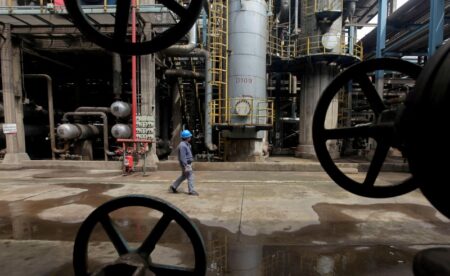Investing.com — Oil prices surged Wednesday, adding to the previous session’s sharp gains after Iran launched a missile attack on Israel, escalating tensions and potentially disrupting crude output from the volatile region.
By 04:35 ET (08.35 GMT), the futures traded 2.1% higher at $71.27 a barrel and the contract climbed 1.7% to $74.97 a barrel.
Crude soars after Iranian missile attack on Israel
Both benchmarks had posted gains of more than 5% Tuesday in the wake of Iran’s biggest ever military blow against Israel in retaliation for its recent killing of Iran-backed Hezbollah leader Hassan Nasrallah and Israel’s deployment of ground forces into south Lebanon.
Iran has said its attack is over, barring further provocation, but Israel vowed the move would be met with “vast destruction”, potentially dragging the United States, its backer, into the turmoil.
“To date, many market participants have faded the risk of physical supply disruptions emanating from the nearly year-long conflict, while Iranian exports have climbed to 1.7mb/d, nearly at six-year highs.” analysts at RBC Capital Markets said, in a note.
“Iran, thus far, has avoided a repeat of the 2019 attacks on regional energy infrastructure,” RBC added. However, “Iran and its proxies could potentially target energy operations in other parts of the region in order to internationalize the cost if the current crisis devolves into an all-out war.”
Additionally, Israel might choose to escalate away from its traditional response of targeting military infrastructure.
“Significant escalation would likely involve targeting Iranian nuclear facilities and energy infrastructure, which would likely boost the risk premium priced into the oil market,” said analysts at ING, in a note.
OPEC+ unlikely to change output
The members of the Organization of Petroleum Exporting Countries and allies, a group widely known as OPEC+, will meet later in the session to review the market.
The group is scheduled to raise output by 180,000 barrels per day each month, starting in December, and thus little change is expected at this meeting.
“Given that a handful of OPEC+ members previously agreed to continue with their full additional voluntary cuts until the end of November, we do not expect the committee to recommend any change to output policy,” ING added.
US crude inventories fall – API
U.S. crude inventories decreased by around 1.46 million barrels for the week ended Sept. 27, according to data from the , released on Tuesday, compared with a draw of 4.3M barrels the previous week.
Economists were expecting a decline of about 2.1M barrels.
Gasoline stockpiles increased by about 909,000 barrels, while distillate inventories — the class of fuels that includes diesel and — declined by 2.67M barrels.
The government inventory report is due later in the session.
Read the full article here














